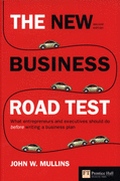
Who is it for?
The new business road test is a must-read for anyone wanting to start a new business, now or in the future, and should be read before writing a business plan. Reading the book will help you identify which of your business ideas are likely to be viable and which should be thrown in the bin.
is a must-read for anyone wanting to start a new business, now or in the future, and should be read before writing a business plan. Reading the book will help you identify which of your business ideas are likely to be viable and which should be thrown in the bin.
Who wrote it?
John W. Mullins, Associate Professor of Management Practice in Entrepreneurship at the London Business School.
The core idea
John W. Mullins contends that there are seven domains that a business must be tested against and pass in order to be successful:
– Will the fish bite?
– Is this a good market?
– Is this a good industry? (Porter’s forces)
– How long will your advantage last? (Building a sustainable advantage)
– What drives your entrepreneurial dream? (What are your personal goals?)
– Can you and your team execute?
– Your connections matter – which matter most?
Why I liked it
This book gave me clarity in an area where entrepreneurs are typically weak – in performing their due diligence. It has allowed me to systematically look at each business idea and evaluate it objectively, without much overhead.
I think it’s compelling enough to make this bold statement, an echo of a statement in the book, that if more entrepreneurs read this book or resources like it we’d have stronger economies. Entrepreneurs are both a scarce resource and the engine for our economic growth and far too often they waste their time, investment opportunities and considerable talent on projects that have no chance of succeeding.
Balance it with:
The Art of the Start by Guy Kawasaki, which covers starting a venture from a holistic, passion-centric position.
by Guy Kawasaki, which covers starting a venture from a holistic, passion-centric position.
Blue Ocean Strategy , which (in spite of being IMHO a very dry book) helps entrepreneurs see beyond fighting in competitive markets (a red ocean strategy) to find new markets where you have no competition (a blue ocean strategy).
, which (in spite of being IMHO a very dry book) helps entrepreneurs see beyond fighting in competitive markets (a red ocean strategy) to find new markets where you have no competition (a blue ocean strategy).



